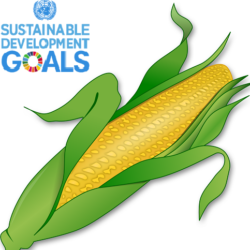
How to Make Food Sustainable

I’ve touched on the importance of agriculture, technology and sustainability before but, considering how vital this partnership is for the future of our world, I think we should look at it with more detail.
Consider, if you will, the recent UN estimates that put Earth’s population at 8.6 billion by 2030 and 9.8 billion by 2050. That’s a lot of mouths to feed living on a strained planet humans will be expecting to produce nourishment.
(And that doesn’t even start to go into the potential dangers of urban sprawl.)
If we are going to feed the world we need to take a good look at our diets and calculate how to balance the various costs and needs.
Let’s take a look at what we can do.
First off let’s look at the strangest yet potentially smartest option: robot farmers.
Yes, I know this seems like the plot of a sci-fi movie but it is actually a real option we are currently exploring.
There are good reasons for this, including speed, accuracy and lack of available farmhands.
Pollen Systems, for one, is offering farms and vineyards a new way to oversee the property, using drones to collect data that can be used to better manage production levels.
The real game changer may prove to be FarmBot, a company aiming to bring robot farming technology to the masses. Offering the technology and know-how to set up anyone—home owners, schools, businesses, etc.—this innovation could bring farming to a greater market.
With the rise in population, increasing urbanization and the added dangers that come with climate change the planet is facing an epidemic when it comes to diseases—and this extends to our food supply.
Modern farmers have to manage the risks that come with a new world full of infections and diseases. On the plus side, technology offers new potential when it comes to managing it all.
Trace Genomics is ready to step in at the get go, working with farmers to ensure their soil is healthy and minimizing the risk of crop diseases.
VakSea, meanwhile, has created a new feed to help protect fish and shrimp from disease, revolutionizing how vaccines are being administered to our food supply.
It should be obvious that we want our food supply to be healthy and it’s good to see technology is rising to the challenge of overtaking modern diseases.
The most obvious way to combat climate change and reduce our global footprint is to shop local whenever possible.
The problem, of course, is we have all become spoiled by the modern grocery store and its global offerings and have become used to having easy access to the world’s bounty at any time.
At the same time, we should all admit that local food tastes better.
If you want to take up the challenge to shop locally, there are (luckily) modern options that make the process easier.
AppHarvest, for example, is working on setting up sustainable greenhouses. Its produce will be grown using less water, fewer pesticides and will dramatically reduce the time food spends travelling to people’s plates.
This is amazing news for our taste buds and bodies.
We know the diet of the future will be different from the diet of our ancestors. Technology has changed so much and will continue to transform how we manage our lives and diets.
That being said, it is still amazing to see how technology is being used to better our lives and shrink our carbon footprint.
We need this innovation, especially as the world’s population continues to grow and, in turn, we increase the number of mouths that need feeding. Whether it’s through robot farmers, genomics or greenhouses, new uses of technology will help us feed ourselves for years to come.

